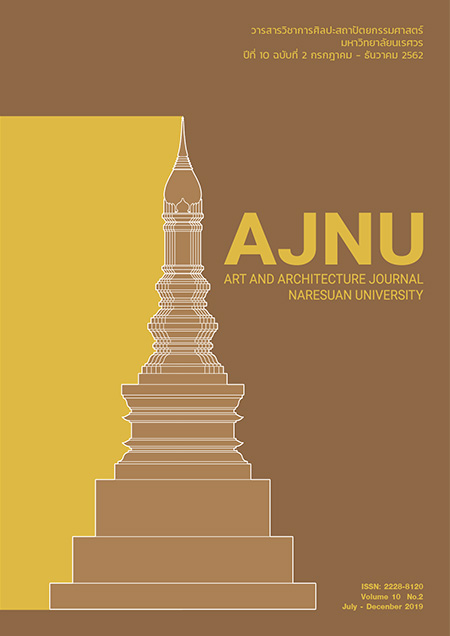A Natural Swimming Pool and Architectural Aesthetics Promotion
Main Article Content
Abstract
This article was aimed to present that human’s way of life formerly related to natural water resource was changed and a swimming pool including a natural swimming pool with circulated ecosystem took relatively more important role in the present. Human’s way of life and biological water treatment were considered important for building a natural swimming pool in order to efficiently create ecosystem and architectural aesthetics, therefore chemicals that might affect users’ health were not needed. Additionally, green space and existence of natural area around architectural work were highly required in the present time. Any places with high natural resource and green scenery would be attractive and accepted by human. The natural swimming pool was an important element of natural area creation that required both swimming pool and green space. The natural swimming pool was another option to make a green space and architectural work coexist as the construction process was not complicated. Also, the relationship between human’s way of life and ecosystem could benefit residential building and create aesthetics of swimming pool in architectural work. This was how to truly go back to nature.
Article Details
References
การจัดตั้งสระว่ายน้ำ พ.ศ. 2530. (14 ตุลาคม 2530) ราชกิจจานุเบกษา. ฉบับพิเศษ หน้า 13 เล่ม 104 ตอนที่ 205
สืบค้นเมื่อ 15 กรกฎาคม 2560. จาก: https://www.mwa.co.th/download/prd01/TIS_gazette/02.PDF
คณะกรรมการสาธารณสุข. (2550). การควบคุมการประกอบกิจการสระว่ายน้ำ หรือกิจการสระว่ายน้ำหรือกิจกรรมอื่นๆ ใน
ทำนองเดียวกัน. ฉบับที่ 1/2550 สืบค้นเมื่อ 6 มีนาคม 2560, จาก: https://www.envilab.com/uploads/
คำแนะนำ%20ควบคุมสระว่ายน้ำ.pdf
จันทนา อึ้งชูศักดิ์, สุรัตน์ มงคลชัย, อรัญญา, ขนิษฐ์ รัตนรังสิมา. (2546). ปัจจัยที่เกี่ยวข้องกับการเกิดฟันกร่อนในผู้ว่ายน้ำ.
วารสารวิจัย มข. ฉบับพิเศษ ปีที่ 3 (หน้า 76-89)
ฝ่ายพัฒนาอนามัยสิ่งแวดล้อมชุมชนและเมือง สำนักอนามัยสิ่งแวดล้อม กรมอนามัย. 2541. สรุปการศึกษาสถานการณ์คุณภาพ
น้ำสระว่ายน้ำในเขตกรุงเทพมหานครและปริมณฑล เอกสารการประชุม “การประกอบกิจการสระว่ายน้ำ”. พิมพ์
ครั้งที่ 1. (ไม่ระบุสถานที่พิมพ์). หน้า 73.
พงศ์ศักดิ์ หนูพันธ์ และรัฐชา ชัยชนะ. (2557). ผลกระทบของไนโตรเจนและฟอสฟอรัสต่อการเกิดยูโทรฟิเคชันในแหล่งน้ำ
และการกำจัดไนโตรเจนและฟอสฟอรัส. วิศวกรรมสาร มก. ฉบับที่ 88 ปีที่ 27 เมษายน - มิถุนายน 2557 (หน้า 57-
67) แพรแก้ว แก้วก่า. (2550). Pool House: รวมตัวอย่างสระว่ายน้ำหลากสไตล์ในบ้านสวย. พิมพ์ครั้งที่ 2
กรุงเทพมหานคร: สำนักพิมพ์บ้านและสวน
Arnau Casanovas-Massana and Anicet R. Blanch. (2013). Characterization of microbial populations associated with natural swimming pools. International Journal of Hygiene and Environmental Health. Volume 216, Issue 2, March 2013, pp.132-137.
Biotop. (2017). Natural Pool System. Retrieved March 6, 2018, from https://gb.bio.top/planning-natural-pool
Michael Littlewood. (2005). Natural Swimming Pools: Inspiration for Harmony with Nature.
Schiffer Publishing: 16-19.
BioNova Natural Pools. The pool reinvented-plants instead of chemicals. Retrieved March 6, 2018, from
https://bionovanaturalpools.com/images/whatweve/BioNova%20Brochure%20Public%20REV%20013
02013.pdf
Minneapolis parks. (2018). Webber Natural Swimming Pool. Retrieved September 25, 2018, from
https://www.minneapolisparks.org/activities__events/water_activities/webber_natural_swimming_po
ol/Nation Spa & Pool Institute. (2003). Professional Pool & Spa Operator 1st, Nation Spa & Pool
Institute, USA, pp.1-28, 2-27, 3-20, 4-17, 5-9, 7-24, 8-11.
Royal Pool. (2018). Rivestimenti in gres per Sistema. Retrieved September 25, 2018, from
http://www.piscinesumisura.it/index.php?piscine_su_misura=piscine_pubbliche


